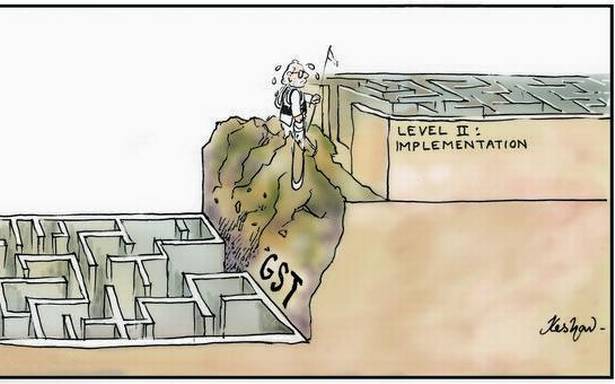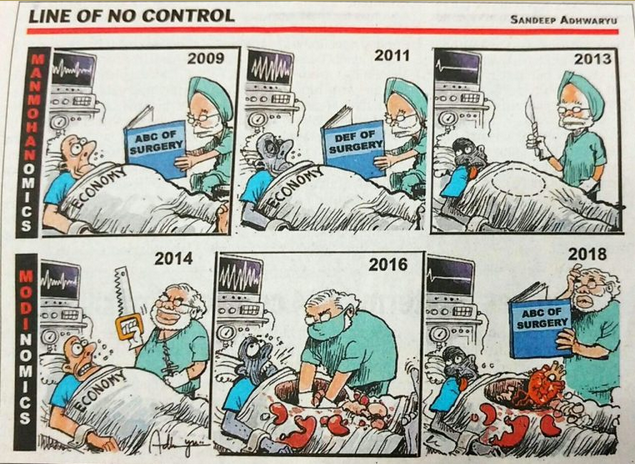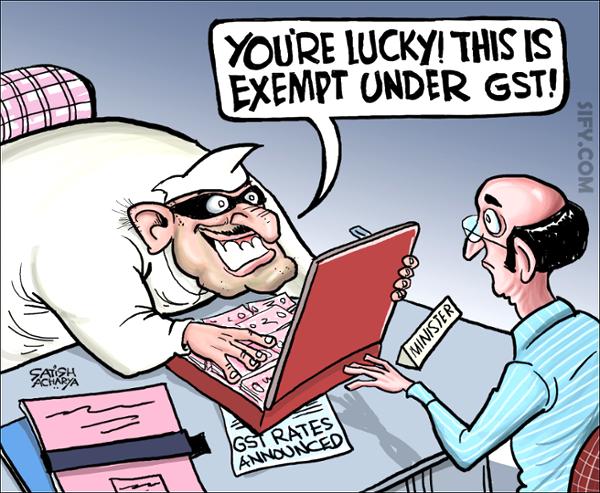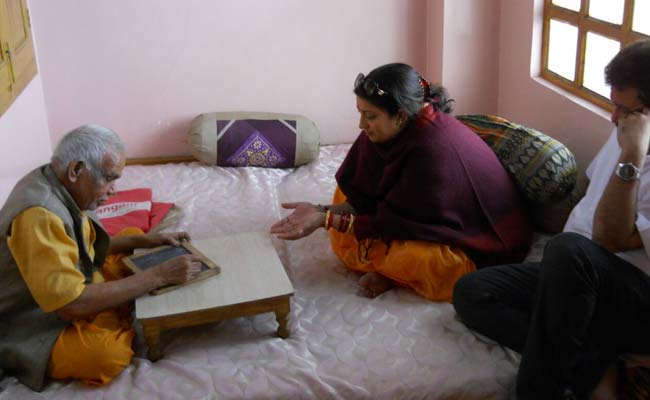Goods and Services Tax, and Gold (Part XV) Below is a scene from anti-GST protests by traders in the Indian city of Surat. On 1st July 2017, India changed the way it imposes indirect taxes. As a result, there has been massive chaos around the country. Many businesses are closed for they don’t know what taxes apply to them, or how to do the paperwork. Factories are shut, and businesses are protesting. [embedded content] Increases in administrative costs have made economics of trading and manufacturing unfavorable for many. Most lack access to accounting and IT skills to implement the new system — India simply does not have that many skilled people. As many as half of all transportation trucks are not operating. The
Topics:
Jayant Bhandari considers the following as important: Debt and the Fallacies of Paper Money, Featured, Narendra Modi, newsletter, On Economy, On Politics
This could be interesting, too:
Nachrichten Ticker - www.finanzen.ch writes Die Performance der Kryptowährungen in KW 9: Das hat sich bei Bitcoin, Ether & Co. getan
Nachrichten Ticker - www.finanzen.ch writes Wer verbirgt sich hinter der Ethereum-Technologie?
Martin Hartmann writes Eine Analyse nach den Lehren von Milton Friedman
Marc Chandler writes March 2025 Monthly
Goods and Services Tax, and Gold (Part XV)Below is a scene from anti-GST protests by traders in the Indian city of Surat. On 1st July 2017, India changed the way it imposes indirect taxes. As a result, there has been massive chaos around the country. Many businesses are closed for they don’t know what taxes apply to them, or how to do the paperwork. Factories are shut, and businesses are protesting. |
|
| Increases in administrative costs have made economics of trading and manufacturing unfavorable for many. Most lack access to accounting and IT skills to implement the new system — India simply does not have that many skilled people. As many as half of all transportation trucks are not operating. The media have “decided” not to cover the demonstrations.
The new indirect tax is a value-added tax, but as can be expected from the Indian government, it is chaotic, bureaucratic, extremely complicated, and full of loopholes. If you pay GST to your supplier but if he fails to deposit it, you cannot claim it as an input tax, making a businessman not only a collector of tax but an enforcer — this kind of draconian VAT system likely does not exist anywhere else. There are about 40 tax returns required each year for each province that a company operates in. While tax officers don’t know how the new system should work, failure to comply will lead to imprisonment. |
|
| There are about seven kinds of rates. Not only do the rates differ based on types of products, but also based on the prices of products. For example, there is a 5% sales tax on footwear if it is priced at less than INR 500, but 18% if it is priced higher. So if the total price is around INR 1,000, footwear stores are selling a pair of footwear as two separate pieces, pricing each piece lower than INR 500. This way they can charge only 5% tax, instead of 18%.
One must ask if the Indian government gave any thought to what would happen if for some reason the price of something like this went up from INR 499 to INR 501. A mere 0.4% change in price would result in the customer paying about 13% more. Imagine the shock a transition of price like this would cause to the demand and supply situation. But, really, Indian bureaucrats never contemplate on such issues. Every regulation is made is to maximize their collection of bribes, or these days to increase tyranny. As Dr. Madhusudan Raj, President of Mises India says:
|
|
| Let’s consider the situation with gold, where the total tax hasn’t changed much, to get a feel for what doing business is like. The total indirect tax (import duty plus GST) on gold is now about 14%, instead of 13% previously. The customer also needs to pay for the cost of import and insurance, the mark-up for the importer, and the mark-up for the retailer. At the very least these costs add about 6% to the landed price.
The final retail price of gold should be around 120% of the international price. Interestingly, you can buy gold for 110% of the international price, and even lower if you buy in bulk. Depending on how efficiently you ran your gold business, you would lose at least 5%-10% on revenue. As a corollary, absolutely the only way to run gold trading or any other business in India is by avoiding payment of taxes, by cheating suppliers and clients, and by externalizing costs. None of these pinch the conscience of Indians. One cannot just blame the system, for the culture feeds it. |
This is now a regular feature of modern India. A courting couple is thrashed by self-appointed moral police. |
Corruption Cannot Be ReducedThe World Bank, the IMF, the US foreign office, the UN, the European Union, assorted poverty alleviation organizations, etc., all think that what countries like India need is a rapid reduction in corruption and an improvement in institutions. They couldn’t be more wrong. They are putting the cart before the horse, have no understanding of ground realities, and zero understanding of cultural issues. What countries like India need is an infusion of the concept of reason, a job that Christian missionaries and the British once performed. It was a very hard, slow and mostly frustrating task that achieved very minimal success in 200-300 years. What distinguishes the West (and its offshoots) from most non-western countries is the conspicuous absence of the concept of reason in the latter. What looks like corruption to the rational mind is completely different from what looks like corruption to the tribal, irrational mind. A completely different operating system dominates such a mind. The owner of a rational mind thinks in terms of what is right and fair, while consciously reducing any influence of tribalism that might influence decisions. He thinks in terms of what enables accumulation of financial and intellectual wealth. He has low time-preference, and he accounts for the rightful needs of the future generation and those outside his own family. The owner of an irrational mind processes the world in terms of what is expedient and “good” for his tribe, unconcerned and totally unsympathetic toward those outside of the tribe. The size of the tribe in his comprehension is barely more than his immediate family and friends. Moreover, his concern for what is “good” for his tribe is underpinned not by empathy — which the irrational mind cannot have — for “family” and “friends”, but a pact for mutual protection. When the situation is no longer personally advantageous, he will instinctively turn against his own tribe. India is a deeply tribal, superstitious and ultimately an extremely irrational society. This has direct implications on the institutions of such a society. Irrational people by definition cannot differentiate between virtue and sin, right and wrong, and lack moral instincts. They cannot have a concept of fairness. Given this, it is inconceivable that India by itself could have developed a modern judiciary and the rule of law from the bottom up. Had the British not left these institutions behind, they would have never come to exist. Since the time they left, these institutions have not only failed to evolve, they can no longer be maintained. They are falling into disrepair, degradation and decay. |
|
| Without infusing the concept of reason into India, which is without exaggeration a process that might take millennia and perhaps longer, what looks like corruption to the outside world simply cannot be reduced in India. Indian institutions are not capable of mirroring Western institutions, except on a superficial level. That is, unless India were to be re-colonized.
Without the British running India, the only sustainable way for India to work optimally is by instituting a tribal set-up, by comprehensive delegation and de-centralization. Instead, India is getting more centralized, with a “one-tax one-nation” system, and enforced digitalization of money and citizen records, all supported by armchair economists and experts sitting at the World Bank, the UN and IMF. This will not end well. |
A public beating administered for an alleged violation of religious precepts. Hindu fanaticism increasingly becomes a regular feature of modern India. While from the right-wing western perspective, Islam looks like a major problem— and it undoubtedly is — it is merely a proximal cause. Islam is a problem due to the collectivization of irrational people. As collectivization (using the tool of nationalism) increases in India, tyranny rapidly becomed palpable. With time, India — which in many ways is no better — will look more and more like the Middle East even in terms of the headlines it generates. |
The Internal Underpinnings for Economic Growth Aren’t ThereIndia continues to be a deeply superstitious society, with the concept of reason conspicuous by its absence. Lacking the concept of reason, Indians can have Phd in Science and still be driven by merely beliefs, superstitions and faith. Here is Smriti Irani, a minister in the federal government, in astrological consultations. According to her astrologer, she will be president by 2019. Astrology is becoming a part of the government’s focus. Madhya Pradesh, a province with a population of 81 million, has recently started college level “education” in astrology and related subjects. It will soon be providing astrology-based out-patient “medical” consultation similar to that provided by conventional hospitals (readers may find the above hard to believe, so here a link to a corroborating report). |
|
| India has failed to elect rational leaders, for superstitious people see no value in such leaders. Without rational guidance, a system can only progress due to outside help, as India did during its colonization by the British and thereafter because Western technology trickled in.
India’s own natural, stable existence is as a subsistence economy, kept in balance by Darwinism. Instead of accumulating financial and intellectual capital, there is a tendency to destroy it. Even the advantages — charity and free gifts of technology — received from outside are frittered away in unproductive activities or consumption. India’s GDP per capita is $1,718. Based on what has been happening in the country — an excessive focus on tax collection at the cost of the welfare of the citizens — it should not come as a surprise if the real economy has contracted. Government statistics may show a different story, for they keep changing how they measure GDP, while the share of government in the economy keeps growing. Over the last one year, a very large informal sector catering to as much as 94% of the population has been systematically starved and destroyed, and the benefits are transferred to the formal economy and the middle class. Official GDP numbers as a result ,ay show an improvement, and tax collection may grow, but that does not change the reality for the majority of citizens. |
Holy cows in prime minister Modi’s “Smart City”. This is a road in a major city of India. The cow has never been more sacred. While holy cows die of starvation in government-funded shelters, those from the “lower caste” and those deemed to have consumed beef are regularly lynched. Headed by Science & Technology Minister Harsh Vardhan, a 19-member committee is “carrying out scientifically validated research on cow derivatives including cow urine, and their benefits.” – no, this is not a joke. |
Happy Tax Collectors, Warriors Lacking Ammunition and a Fragile BoomIn the worldview of the Middle Class and the government what matters is tax collection. What happens to 94% of the people of India — a rather wretched group — is immaterial. The informal sector is the backbone of the Indian economy. It subsidizes the formal sector. As the informal sector continues to suffer, ironically, the middle class will start to see massive job losses and government a fall in tax collection. However, they will fail to see the causality. No economic degradation like this can happen without social strife, and eventually a possible war. Dr Madhusudan Raj, President of Mises India notes in this context:
If one understands the irrational aspect of the “Indian operating system”, one also understands that India will continue to do wrong in trying to correct the problems created by earlier wrongs. |
Most polluted cities are in IndiaWhile people talk about pollution in China, it is India that has the rare distinction of having the most polluted cities. The country is ridden with human faeces and garbage. Absolutely every single water body is heavily polluted. Diseases run rampant. Millions die unaccounted for from easily treatable diseases. 13.7% Indians are believed to be mentally ill. The National Institute of Mental Health & Neurosciences recommends “active medical intervention” for at least 150 million people, which is equivalent to the entire adult population of the US. Ironically, India has achieved this distinction without having developed its industrial sector, which amounts to only 18% of GDP. |
| Today, Indians are very proud of its so-called booming economy, preferring to see the world through media headlines rather than through their own eyes. They should actually be horrified. At a GDP of US$1,718 per head, India is among the poorest places in the world, poorer than Africa on a per capita basis. A high growth rate in a country that is starting from such an abysmally low base doesn’t mean much.
Alas, even the relatively faster growth over the last three decades can be mostly attributed to extraneous events, particularly the advent of the internet (which was a free gift from the West) and the rapid outsourcing of back-office work and coding that it enabled. Initially the wage differential was so astronomical that it was a no-brainer to transfer some basic work to India. Every sign is that these benefits are now tapering off, as the low hanging fruit have been plucked. Worse, as China and the Philippines continue to improve their competitive advantages, India is suffering an exodus of business. India’s extremely low GDP per capita paints a picture of more than a billion people leading a medieval lifestyle, people who lack modern basics like electricity, running water, toilets, etc. Despite the low starting base, the Indian economy is moreover clearly faltering, something the media are willfully ignoring. |
Chart by: Statista
Image captions by PT where indicated
Edited by PT
Note: Linked here are earlier articles in this series
Coming next: The Reality of the Information Technology Industry
Tags: Featured,Narendra Modi,newsletter,On Economy,On Politics






